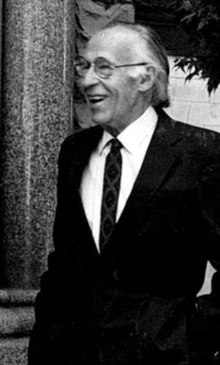Victor Steinbrueck
This article includes a list of references, related reading, or external links, but its sources remain unclear because it lacks inline citations. (May 2008) |
Victor Steinbrueck | |
|---|---|
 | |
| Born | December 15, 1911 |
| Died | February 14, 1985 (aged 73) |
| Alma mater | University of Washington College of Architecture |
| Occupation | Architect |
| Awards | American Institute of Architects Fellow |
| Practice | private, John Graham & Company |
| Buildings | Space Needle |
| Projects | Pioneer Square and Pike Place Market preservation |
Victor Steinbrueck (December 15, 1911 - February 14, 1985) was a Seattle architect, and University of Washington faculty member, and best known for his efforts to preserve the city's Pioneer Square and Pike Place Market.
Biography
Steinbrueck was born in Mandan, North Dakota, and came to Seattle in 1913. In 1930 he enrolled in the University of Washington Program in Architecture, graduating in 1935 with a Bachelor of Architecture (B.Arch.). In this period he also worked in the Civilian Conservation Corps. After apprenticing in a number of private Seattle firms and serving in the military during World War II, he joined the Faculty of Architecture at the University of Washington in 1946. He also initiated his own practice and, over the next two decades, designed a series of regional-modernist residences, built with indigenous materials suited to the climate.
Steinbrueck's focus on the character of Seattle's architecture and urban places dates from the early 1950s when he authored A Guide to Seattle Architecture, published for American Institute of Architects national convention held in Seattle in 1953. Steinbrueck went on to publish several other books promoting awareness of the unique character of Seattle: Seattle Cityscape (1962; published to coincide with Century 21, the Seattle World's Fair), Market Sketchbook (1968), and Seattle Cityscape #2 (1973).
In the 1960s Steinbruck became active in historic preservation, and, with others, successfully fought developers' plans to obliterate Seattle's most significant historic district. He was instrumental in the creation of Seattle's first two historic districts, Pioneer Square (1970) and Pike Place Market (1971). His own projects were guided by a strong sense of public spirit and social consciousness: low-income housing, the inclusion of social services, and a number of city parks co-designed with landscape architect Richard Haag, including the one that now bears his name.
Working as a consultant to John Graham & Company, Steinbrueck played a key role in the design work of the Space Needle. In 1963, Steinbrueck was elected a Fellow in the American Institute of Architects.
Publications
- Steinbrueck, Victor, A Guide to Seattle Architecture, 1850-1953, Reinhold Publishing Co., New York 1953.
- Steinbrueck, Victor, Seattle Cityscape, University of Washington Press, Seattle 1962
- Steinbrueck, Victor, Market Sketchbook, University of Washington Press, Seattle 1968
- Steinbrueck, Victor, Seattle Cityscape #2, University of Washington Press, Seattle and London 1973
- Steinbrueck, Victor, and Nyberg, Folke, A Visual Inventory of Buildings and Urban Design Resources for Seattle, Washington, Historic Seattle Preservation and Development Authority, Seattle 1975-77. Available from Historic Seattle
See also
- Victor Steinbrueck Park (Seattle)
References
- Veith, Thomas, "Victor Steinbrueck," in Shaping Seattle Architecture: A Historical Guide to the Architects (Jeffrey Karl Ochsner, ed.), University of Washington Press, Seattle and London, 1994, pages 276-281
- Ochsner, Jeffrey Karl, "Victor Steinbrueck Finds His Voice: From the Argus to Seattle Cityscape," Pacific Northwest Quarterly 99/3 (Summer 2008), pages 122-133.
External links
- Steinbrueck, Victor Eugene (1911-1985) at HistoryLink.org
- Victor Steinbrueck, Life & Ideas
- Photographs of Victor Steinbrueck's works from the Phyllis and Robert Massar Photograph Collection of Pacific Northwest Architecture - University of Washington Digital Collection
- 1911 births
- 1985 deaths
- Fellows of the American Institute of Architects
- Modernist architects from the United States
- People from Mandan, North Dakota
- University of Washington alumni
- University of Washington faculty
- Writers from Seattle
- Pike Place Market
- Architects from Seattle
- Preservationist architects
- 20th-century American architects
- 20th-century historians
